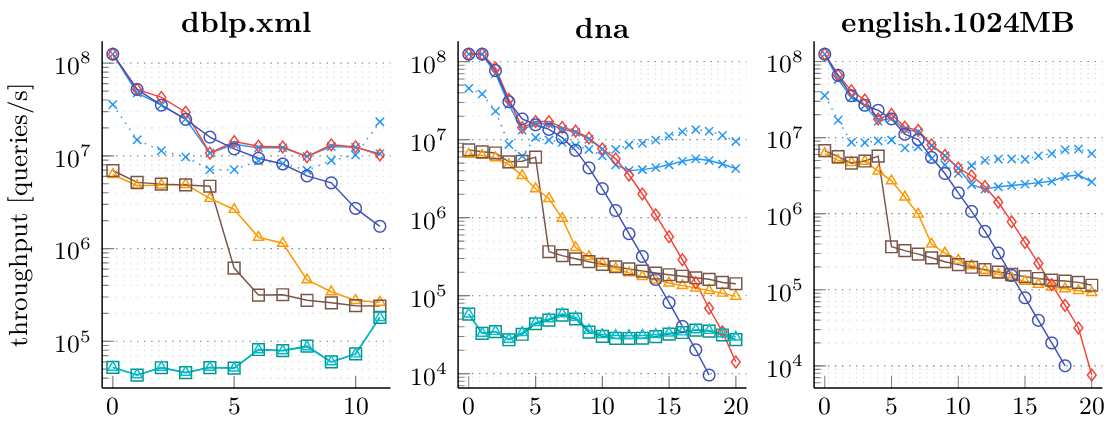Space Efficient Data Structures for Longest Common Extensions
The longest common extension (LCE) of two text positions in a text is the maximum size of a common substring starting at those positions, i.e., more formally
.
This repository contains different implementations to compute LCEs using different techniques:
- simply scanning the text naively
- simply scanning the text naively (but using 128 bit integers to pack characters)
- computing in-place fingerprints
- using string synchronizing sets
For easier comparison, we also provide the different implementations (based on in-place fingerprints and using data structures contained in the SDSL).
Extensive Evaluation
Using this code, we provide an extensive evaluation of different techniques to compute LCEs. We give a short excerpt below.
More experiments and a description of the legend can be found in our paper which has been accepted at ESA2020. Please cite the following paper if you are using our code.
@inproceedings{DinklageFHKK20,
author = {Patrick Dinklage and
Johannes Fischer and
Alexander Herlez and
Tomasz Kociumaka and
Florian Kurpicz},
title = {Practical Performance of Space Efficient Data Structures for Longest Common Extensions},
booktitle = {Accepted at European Symposium on Algorithms (ESA) 2020}}
}
How to Build the Code
First, we clone the code and submodules:
git clone https://github.com/herlez/lce-test.git
cd lce-test
git submodule update --init --recursive
Then we build the code:
mkdir build
cd build
cmake -DCMAKE_BUILD_TYPE=Release ..
If we want detailed information (timings and memory requirements) of the string synchronizing set LCE data structure, we have to use -DDETAILED_TIME=True.
Note that this options invalidates all other times and memory measurements for this data structure.## How to use the Benchmark Tool
How to Use the Benchmark Tool
Now, that we have built the code, we can use our benchmark tool to evaluate the data structures.
To this end, change to build/benchmark.
To get an overview about all possible benchmark parameters, we can use benchmark_time -help.
There are two different modes (-m or --modes) for our benchmarks:
- random, which asks random queries and
- sorted, which asks queries that have a specific size as result.
In the second case, we can control the size of the result using --from and --to, which translate to queries in the range .
These queries are precomputed and stored at
/tmp/res_lce.
We can change this directory using the -o or --output_path to specify another directory.
In the directory, we find a folder for each tested text (and each prefix size). The folder will contain a file for each length, e.g., for the dblp.xml file from the Pizza & Chili Corpus we obtain the following files:
[kurpicz dblp.xml]$ ls -al
drwxrwxr-x 2 kurpicz kurpicz 23 Dec 14 2019 .
drwxrwxr-x 19 kurpicz kurpicz 19 Dec 15 2019 ..
-rw-rw-r-- 1 kurpicz kurpicz 1812 Dec 14 2019 lce_0
-rw-rw-r-- 1 kurpicz kurpicz 135815 Dec 14 2019 lce_1
-rw-rw-r-- 1 kurpicz kurpicz 79030 Dec 14 2019 lce_10
-rw-rw-r-- 1 kurpicz kurpicz 1098 Dec 14 2019 lce_11
-rw-rw-r-- 1 kurpicz kurpicz 0 Dec 14 2019 lce_12
-rw-rw-r-- 1 kurpicz kurpicz 0 Dec 14 2019 lce_13
-rw-rw-r-- 1 kurpicz kurpicz 0 Dec 14 2019 lce_14
-rw-rw-r-- 1 kurpicz kurpicz 0 Dec 14 2019 lce_15
-rw-rw-r-- 1 kurpicz kurpicz 0 Dec 14 2019 lce_16
-rw-rw-r-- 1 kurpicz kurpicz 0 Dec 14 2019 lce_17
-rw-rw-r-- 1 kurpicz kurpicz 0 Dec 14 2019 lce_18
-rw-rw-r-- 1 kurpicz kurpicz 0 Dec 14 2019 lce_19
-rw-rw-r-- 1 kurpicz kurpicz 1923480 Dec 14 2019 lce_2
-rw-rw-r-- 1 kurpicz kurpicz 1924228 Dec 14 2019 lce_3
-rw-rw-r-- 1 kurpicz kurpicz 1934100 Dec 14 2019 lce_4
-rw-rw-r-- 1 kurpicz kurpicz 1930429 Dec 14 2019 lce_5
-rw-rw-r-- 1 kurpicz kurpicz 1798256 Dec 14 2019 lce_6
-rw-rw-r-- 1 kurpicz kurpicz 1863382 Dec 14 2019 lce_7
-rw-rw-r-- 1 kurpicz kurpicz 1973395 Dec 14 2019 lce_8
-rw-rw-r-- 1 kurpicz kurpicz 1047701 Dec 14 2019 lce_9
-rw-rw-r-- 1 kurpicz kurpicz 0 Dec 14 2019 lce_X
Here, the number i after at the end of the file name refers two queries of length . The X refers to queries that are longer than
. If a file is empty, there are no text positions that would result in a query of the requested length.
Otherwise, two lines 2i and 2i+1 for i=0,1,... are a pair of text positions that result in a query of the length indicated by the file name.
The Output
The output of the benchmark looks similar to this (depending on your specific parameter configuration):
RESULT algo=sss256 runs=5 sss_construct_time=42961 pred_construct_time=65 string_sort_time=145024 sa_construct_time=27162 lcp_construct_time=129389 rmq_construct_time=1768 sync_set_size=31630093 construction_min_time=339954 construction_max_time=352858 construction_avg_time=344512 input=/work/kurpicz/pizza_chili_repetitive/cere size=461286644 lce_mem=662279960 construction_mem_peak=2638599596
Above, we see the timings and memory usage for the construction of a string synchronizing set LCE data structure. All times are given in milliseconds. The total time the construction_[min|max|avg]_time, where min, max, and avg are the minimum, maximum, and average of the construction times of all runs (in this example 5). The final memory requirements are shown as lce_mem and the memory peak during construction is described as construction_mem_peak. Note that both measurements can be the same (if the data structure can be computed in-place).
RESULT algo=sss256_queries runs=5 lce_query_type=sorted length_exp=1 input=/work/smflkurp/pizza_chili_repetitive/cere size=461286644 lce_values_min=1 lce_values_max=1 lce_values_avg=1 lce_values_count=5000000 queries_times_min=8 queries_times_max=8 queries_times_avg=8 check=passed
RESULT algo=sss256_queries runs=5 lce_query_type=sorted length_exp=20 input=/work/smflkurp/pizza_chili_repetitive/cere size=461286644 lce_values_min=18446744073709551615 lce_values_max=0 lce_values_avg=0 lce_values_count=0 queries_times_min=18446744073709551615 queries_times_max=0 queries_times_avg=0 check=passed
Then, there are also the results for the queries. Here, we describe the length of the queries as length_exp, which translates to queries from the file lce\__length\_exp_. The number of answered queries is lce_values_count. Note that we count the number of queries in all runs. If there are no queries, the queries_times_min can is 18446744073709551615 (64-bit unsigned integer). Otherwise, queries_times_[min|max|avg] are the minimum, maximum, and average of the times required to answer the queries of all runs.

